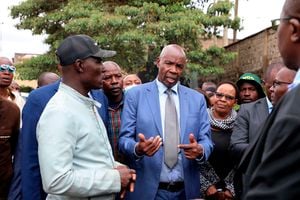Nairobi leg of UN’s Summit for the Future a key bridge

The United Nations flag. Civil society is required to be accredited – or hold ‘consultative status’ with a UN entity
Non-governmental actors across the world will meet next month for the United Nations Civil Society Conference as a tentpole moment leading up to the Summit for the Future.
For the first time in 68 years, the conference is being held in the Global South, with its first stop in Nairobi.
While this decision is a welcome step towards inclusivity, it is imperative that Nairobi is not simply engaging in service provision for the delivery of the conference.
African civil society must therefore leverage this critical chance to deepen collaboration to advance a unified and audible continental position that will influence the global development agenda, informed by the African Union Agenda 2063: The Africa We Want.
In recognising that we are off track – and in some cases regressing towards attaining our sustainable development goals by 2030; additionally acknowledging emerging threats to our collective goals for people and planet, the UN Secretary General, Antonio Guterres launched Our Common Agenda to increase cooperation towards mitigation and acceleration of progress that resulted in a three-pronged framework.
First, negotiations for the Pact for the Future that is co-facilitated by Germany and Namibia; second is the Declaration on Future Generations co-facilitated by the Netherlands and Jamaica; and finally the Global Digital Compact co-facilitated by Sweden and Zambia.
While processes towards the final adoption of these documents are UN member state-led, there is opportunity for meaningful civil society engagement.
One way is through an interactive dialogue with representatives of these governments who will be present to listen to civil society that will inform their negotiations towards these three documents.
Consider that often civil society is required to be accredited – or hold ‘consultative status’ with a UN entity to enable them to officially engage in multilateral processes.
This extends to their participation in conferences, including making policy recommendations to member states and consequently demanding implementation on commitments. Getting this status comes with prerequisites which are ideally to maintain checks and balances.
Inversely, it locks out civil society including those operating at grassroots levels that contend with complex power dynamics that result to their exclusion. This requirement was removed for the Nairobi Conference to encourage wider participation.
Instead, proof of recognition by a national level regulatory body in a UN member suffices. There is power in voices not commonly heard.
Africa has the world’s youngest and fastest growing population. With a median age of 19, it is projected to exponentially grow over the next decade, surpassing the billion people mark. While this provides immense economic prospects, these opportunities will only succeed if identified, made visible and harnessed.
Several moments have been curated for youth engagement at the conference including a youth pre-conference and a youth pavilion at the main conference for exchange and artistic expressions.
While it has previously been argued that there will be no conference outcome, it is to be noted that a hub for civil society multi-stakeholder hub for “ImPACT Coalitions,” will be created to work towards advancing key reform initiatives leading up to and beyond the Summit of the Future. A second outcome will be co-Chair’s summary as a record and summary of the conference itself.
Civil society must read the Pact for the Future, the Declaration on Future Generations, and the Global Digital Compact to identify and promote priority issues and collaborative opportunities for the continent that will inform the global post-2030 agenda. In this way implementation imperatives will trickle down to achieve the no one is left behind goal.
- Stephanie Musho is a human rights lawyer and a Senior New Voices Fellow at the Aspen Institute.




